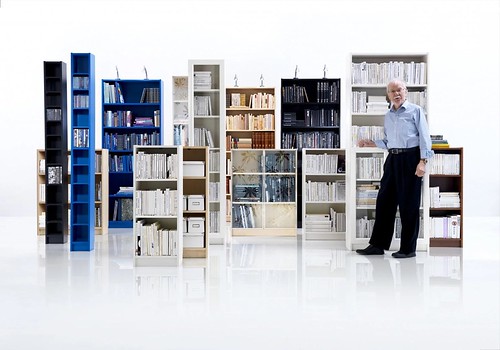
PREV ARTICLE
NEXT ARTICLE
FULL ISSUE
PREV FULL ISSUE
IKEA’S UBIQUITOUS BILLY BOOKCASE DESIGNER DIES
Bibliophiles may choose to hold a moment of silence to honor the designer responsible for what must be the world's most ubiquitous
cheap bookcase. Here's an excerpt from the March 11, 2016 Washington Post. -Editor

Gillis Lundgren, an industrial designer who helped make Ikea the largest furniture retailer in the world with his no-frills designs, most notably the Billy bookcase that millions of frugal book collectors have used to build their home libraries, has died at 86. Kajsa Johansson, an Ikea spokeswoman, confirmed his death, describing him as “a man full of ideas that he quickly turned into practical products,” but gave no other details. Mr. Lundgren joined Ikea in 1953 as the company’s fourth employee and advanced to become its first design manager. A draftsman with training in graphics, he designed hundreds of Ikea’s simple, portable furnishings and was credited with creating the company logo, whose blue and yellow colors were taken from the Swedish flag. Although few of those people are likely to know Mr. Lundgren’s name, all of them are or will soon become acquainted with perhaps his most significant contribution to the Ikea business model: “flat-pack” furniture. Ikea was not the first company to employ the now-ubiquitous system, but Mr. Lundgren was credited with perfecting it for Ikea’s purposes. He said the idea came to him early in his career. Ikea had recently entered the furniture market, he recalled, and “storage space became an issue.” Today, shoppers peruse fully assembled Ikea wares in showrooms and on the company’s website but take home (or order for delivery) boxes that contain the products in pieces, neatly stacked, to be assembled on arrival. The flat-pack system allows Ikea to save money by moving its products more efficiently and customers to save money, although not time, by providing the labor. Many shoppers who enter an Ikea warehouse, no matter how few their belongings or how small their home, have at least a few books to place on a shelf and at least one wall against which to rest it. Those shoppers may not, however, have a large amount of money to part with. And so they may go home with a Billy bookcase, created by Mr. Lundgren and introduced in 1978. He was said to have drawn the design on a napkin. “Ideas are perishable,” he once remarked, “and you have to capture the moment as soon as it arrives.” Billy’s plain shelves of varying heights and widths proved imperishable and remain largely unchanged from Mr. Lundgren’s original design. Because of improvements in production efficiency, the product line costs less today than it did at its debut, with one basic model on sale for $69.99. “I want to create solutions for everyday based on people’s needs,” Australian newspapers quoted him as saying. “My products are simple, practical and useful for everyone, no matter how old you are or what your life situation.” To read the complete article, see:
THE BOOK BAZARREWayne Homren, Editor The Numismatic Bibliomania Society is a non-profit organization promoting numismatic literature. See our web site at coinbooks.org. To submit items for publication in The E-Sylum, write to the Editor at this address: whomren@gmail.com To subscribe go to: https://my.binhost.com/lists/listinfo/esylum All Rights Reserved. NBS Home Page Contact the NBS webmaster 
|